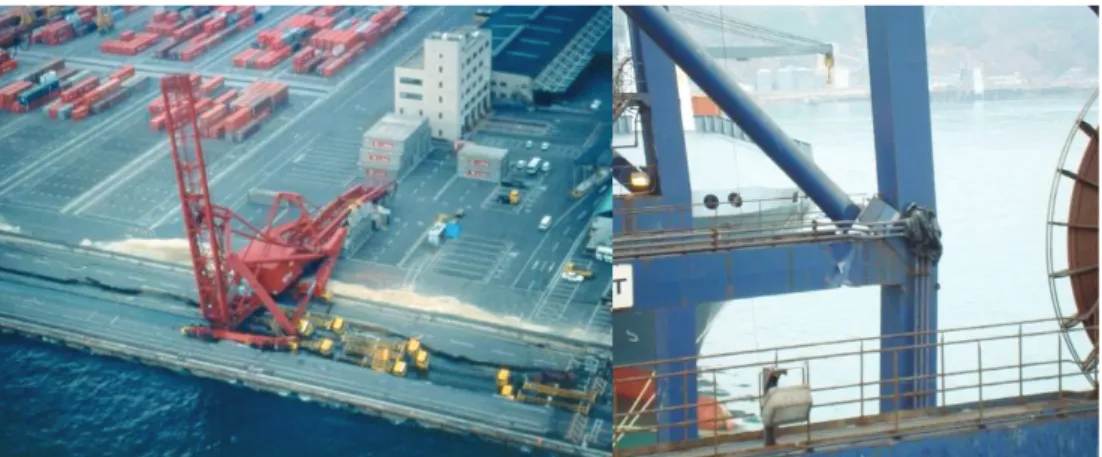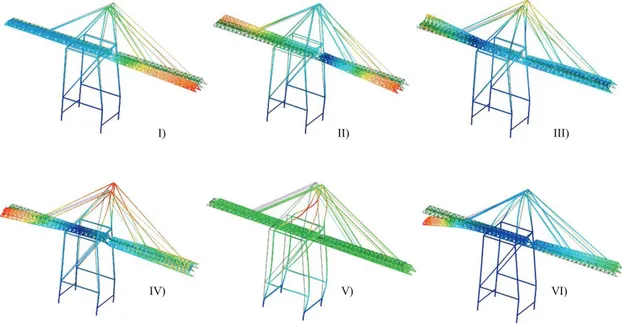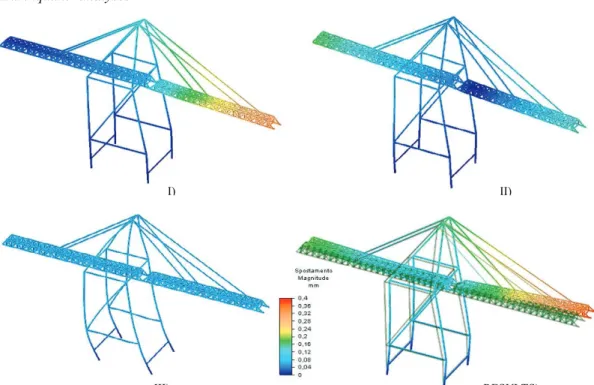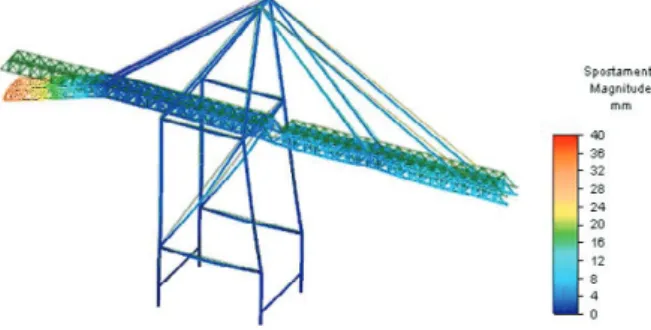ICM11
Ship to shore crane subjected to earthquake
L.Solazzi
Departement of Mechanical and industrial Engineering, Faculty of Engineering, University of Brescia, Via Branze 38, 25123 Brescia, Italy e-mail: [email protected]
Abstract
This paper is concerned the dynamical behaviour of the lifting machine and in particular the ship to shore crane subject to the earthquake. The reason of this work starts at the observation that the components of the crane may be subjected to very high stress and so the earthquake may be very dangerous. There are many phenomena induced by the earthquake like local and global buckling, and overturning moment which may lead to the collapse of the crane components. The paper wants to answer to the question if the earthquake is more dangerous than the normal operating conditions for the ship to shore crane and if the answer is yes, it is very important to know the differences. For this scope, the first step regards the whole design, by the standards, a very big ship to shore crane. The main parameters are: • height=33+15 m; • working load limit=450 kN.
After that, a solid model and subsequent fem analyses were performed in order to verify the safety factors for different load conditions that the crane may be subjected. The next step regards the dynamical analyses like modal analyses for evaluation both the deformation and natural frequencies and both the modal participation factors. The last step concerns the application of specific spectrums of acceleration to simulate a possible earthquake in the Italian region. The results shows that, in this specific case , the actions induce by earthquake are very low.
Keyworlds: crane; lifting equipment; earthquake ; dynamical behaviour.
1. Development
The aim of this paper is to analyze the dynamical behavior of the crane and in particular the ship to shore crane which is the most popular crane utilized in the port form moving the container from and to ship. In particular, in this paper we want to analyze the effect of the earthquake on this structure and if the
doi:10.1016/j.proeng.2011.04.448 Procedia Engineering 10 (2011) 2690–2695
1877-7058 © 2011 Published by Elsevier Ltd.
Selection and peer-review under responsibility of ICM11
Open access under CC BY-NC-ND license. © 2011 Published by Elsevier Ltd.
Selection and peer-review under responsibility of ICM11
earthquake is most dangerous for the structures than the lifting operations . The fig. 1 shows a classical ship to shore crane.
Fig. 1. Classical ship to shore crane.
During the last earthquake, like Kobe (17/01/1995), different cranes collapsed causing considerable damage also in economic terms. From this earthquake, the scientific attention began to focus also on these types of structures. The main mode of failure of these structures may be the local or global buckling phenomena. Another effect may be the failure of the port structures like pier that leading to collapse the whole of crane. The fig. 2 shows same of this failure.
Fig. 2. Typical failure mode of cranes by earthquake.
The reason of this work start at the observation that there are not a specific procedure for evaluation the crane subject to earthquake and the collapsed of these components may be very dangerous economic topic and in particular also in the post earthquake or in another word in the rehabilitation. At present there is only a draft standard under consideration especially with cooperation of Japanese working group that will then be integrated into various standards for the design of cranes.
1.1. Specific of a crane
The first step of this work regard the design of the specific crane. The main features are as follows: payload 450 kN; total length of the beam =125 m; lift height from ground level = 33 m; maximum lifting height below ground level = 15 m. The schematic and specific of the crane are in the next figure, while the fig. 4 report the size of the arm lift.
Fig. 3. Characteristic of the crane designed [m].
Fig. 4. Size of the arm lift and section [m].
The weight of each part are reported in the next table.
1.2. Specific earthquake
The evaluation of the earthquake is very complex depending from numerous variables that can change very significantly the structural response of the structure. There are several disciplines involved in the analysis of earthquakes and for characterization the mathematical formulation. In this paper we have taken the formula proposed by the new Italian technical standard 2008 (that are in according to those proposed by Eurocode 8) and in order to evaluate the influence of the earthquake we assume an elastic loading spectra for horizontal plane actions reported in fig. 5. This graph may be corresponding at medium earthquake in the Italian Region.
Fig. 5. Spectra of acceleration.
1.3. Modal analyses
After the design of the crane and made solid and fem model for verify the analytical results acquire in the static stress analyses, the next step performed regard the modal analyses. The next figure shows the first deformation of the structure.
Fig. 6. First VI deformation of the structure in their frequencies.
I) II) III)
Table 2. Natural frequencies.
The previous table shows first six natural frequencies and the mass participation coefficients. From these values is possible to make same important observations. The first regard that the crane shows a very low natural frequencies ( these values are reduced further and significantly if we considerer the pay load); the second that the mass moved in the first natural frequencies in the transversal directions (x and y) occurs with frequency values are very low and near 2Hz and so the respective effect on the spectrum of acceleration shows a low amplifier effects. In particular if we consider the first natural frequencies witch value is 4.88 e-1 Hz, which corresponds a period about 2 s, the value of acceleration in the load spectra is about 0.7 m/s^2, which is very low in relation to the other possible external actions that can act on the structure such as the actions of the wind.
1.4. Earthquake analyses
Fig. 7. Deformation of crane in corresponding of the I,II and II natural mode of vibration and like results for the spectra input. I) II)
The fig. 7 shows the deformation of the structure induce buy the spectra loading describe above. From these figures (shown with the same legend whose scale is equal to 0.4 mm) is è possible to observe that the main contribution to the total or result deformation is due to the first natural frequencies and that the maximum deformation along the axis of the arm (x direction) occur in corresponding to the third mode which the maximum perceptual of the mass in this direction.
2. Results
The fig.7 shows the deformation induce by a static analyze or in other words by the self or dead weight of the crane. There are two important different respect to the earthquake analyses. The first regard the shape of the deformation which is very different and in particular in this case is important the vertical displacement of the arm (specifically at the end of the arm). The second regards the different magnitude in the displacement value. In the static stress analyses, the displacement is about ten time than in the earthquake analyses, similar consideration may be performed for the value of the stress in the structural component, like portal frame and legs.
Fig. 8. Deformation of the crane induce by the static dead load. 3. Conclusions
This paper represents a preliminary result in order to evaluate the mechanical behaviour of a very big ship to shore crane specially designed subject to the earthquake. And in particular, subject to the medium earthquake that may be performed in the Italian Region. In synthesis of the results show that the effect of the earthquake on this structure appears to be at least an order of magnitude lower than the static actions induced by the weight on the structure (results that are justified by the low values in the first natural frequencies). Development in this work regards three different aspects. The first on the evaluation of the presence of pay load and its position on the crane ( for example during loading and unloading of containers). The second regards the different position of the arm of the crane (which, compared to the current configuration when the arm is rearing can significantly raise the center of gravity of the crane itself). The third regards the evaluation of the influence of earthquakes with different entities on the dynamic behavior / structural of the crane.
References
[1] W. F. Chen, C. Scawthorn. Eartquake engineering handbook. Crc Press; 2003.
[2] A. K. Chopra. Dynamics of structures- theory and applications to earthquke engineering. Prentice - Hall; 1995.
[3] L. Solazzi. Design of an elevating work platform considering both the first and the second order effects and the inertial ones, Second International Conference on Material and Component Performance Under Variable Amplitude Loading, Darmstadt, Germany, March 223/26,2009.

![Fig. 3. Characteristic of the crane designed [m].](https://thumb-eu.123doks.com/thumbv2/123dokorg/5540209.65332/3.841.210.610.260.472/fig-characteristic-crane-designed-m.webp)


